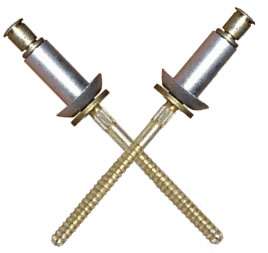
Rivets are commonly used in the construction of airplanes. They are mechanical fasteners that, like other fasteners, are used to secure two or more parts. Rivets, however, are permanent mechanical fasteners. You can typically remove bolts and screws by turning them counterclockwise with the appropriate bit, but you can’t remove rivets after installing them.
As permanent mechanical fasteners, rivets are protected from vibrations. They won’t loosen when exposed to vibrations. But there are different types of rivets, including solid and blind. What’s the difference between solid and blind rivets exactly?
What Are Solid Rivets?
Solid rivets are permanent mechanical fasteners that feature a solid body. They require access to both sides of the parts. Most solid rivets consist of a metal shaft body that’s connected to a head on one end. You can install them using a special tool, such as a rivet gun. The tool will deform the opposite end of the shaft body so that it wraps around the parts with which it’s used.
What Are Blind Rivets?
Blind rivets are permanent mechanical fasteners that feature a hollow body. Also known as hollow rivets, they only require access to one side of the parts. They feature a shaft body as well, and they require a special tool to install. Blind rivets, though, are hollow. You can find them in different styles, but all blind rivets are hollow and require access to one side of the parts with which they are used.
Differences Between Solid and Blind Rivets
Most rivets can be categorized as either solid or blind depending on how they are installed. Solid rivets require access to both sides of the parts to install, whereas blind rivets only require access to one side of the parts.
Blind rivets are a relatively new invention. Before they were invented, aerospace manufacturers — as well as other manufacturers — were limited to using solid rivets. Solid rivets are simple mechanical fasteners that are characterized by a solid construction. The problem with solid rivets is that they require access to both sides of the parts to install.
You may not be able to access both sides of the parts. Rather, you may only be able to access the front of the parts, in which case you won’t be able to use a solid rivet. The good news is that blind rivets offer a solution. Blind rivets only require access to one side of the parts. You can typically install them by using a tool to draw the mandrel through the rivet.



